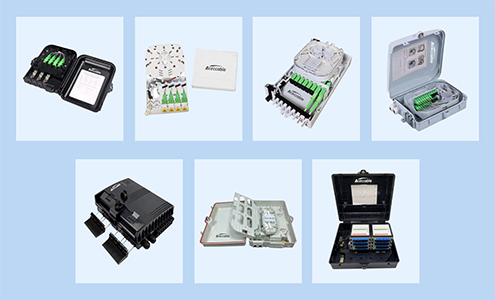THE EVOLUTION OF OPTICAL ACCESS NETWORKS IN THE 5G ERA AS MOST IMPORTANT
Challenges and Opportunities Faced by Optical Access Networks in the 5G Era
As the most important information and communication infrastructure for the digital transformation of the entire society, 5G will achieve the interconnection of all things, connecting and integrating people, machines, environments, etc. more closely and efficiently. Convenient, fast, intelligent, and reliable ubiquitous communication connections will trigger innovation and evolution of production models, business models, and lifestyles throughout society.
Compared to 4G, 5G can provide stronger services, which can be divided into three telecommunications service scenarios: first, enhanced mobile broadband (eMBB) with a peak rate of up to 10Gbps; second, connected to the Internet of Things (mMTC) with a connection count of up to 1 million per square kilometer; and third, low latency, high reliability communication (URLLC) with an end-to-end latency of 1ms, such as the Internet of Vehicles.
We see that 5G’s bandwidth improvement, delay reduction and stronger support for the Internet of Things also pose a huge challenge to the traditional optical access network: first, for traditional Internet services, the bandwidth of mobile users is increased to 1~10Gbps, and the delay is reduced to 1~10ms, which is basically equivalent to the fixed network optical access performance. The bandwidth and delay advantages of traditional optical access are lost in front of 5G, and the convenience of mobile will increase the transfer of more traffic to 5G wireless networks; Secondly, for IoT services, compared to using IoT gateways for optical access networks, 5G IoT has a wide coverage area, convenient business distribution, standardized interfaces, and is easier to operate and reduce costs.
On the other hand, the development of 5G brings new opportunities to optical access networks. Firstly, 5G adopts a separate architecture of AAU and DU, and due to high-frequency imports, the number of 5G AAUs is huge, more than twice that of the 4G era. Therefore, the 5G fronthaul network has become very important, and fiber optic resources have become the key to deployment; The currently built high-density coverage ODN network can easily access 5G AAU at low cost and on demand, providing broad application prospects for technologies such as WDM-PON. Secondly, 5G uses high-frequency signals with weak wall penetration capability, and there are also issues of bandwidth degradation and unstable access quality at the edge of wireless networks. In contrast, the bandwidth and service quality of optical access fixed network users are independent of distance, which is a huge advantage.
Operators can consider combining the advantages of 5G wireless access and optical access to form a supplement, relying on the existing network’s huge ODN fiber resources and stable high bandwidth access, to provide users with stable and reliable 5G+FTTH dual gigabit access.
Evolution Trends and Technological Hotspots of Optical Access Networks
In order to achieve 5G+FTTH dual gigabit access, optical access networks need to consider the evolution of wired and wireless integration, which is specifically reflected in planning and construction, network architecture, technical paths, and other aspects.
From the perspective of planning and construction, it is necessary to consider current business coverage and future business expansion when planning fiber optic network coverage and data center construction. Establishing a comprehensive service access area is an effective method, which divides various service access needs such as fixed line home width, wireless base stations, government and enterprise services into independent comprehensive service access areas based on the division of administrative and natural areas, road network structure, and customer distribution. Each comprehensive service access area includes a dense coverage ODN network and a comprehensive access room. The comprehensive access room uniformly deploys fixed line OLT, wireless BBU/DU, wired transmission and other equipment to achieve fixed mobile co station.
From the perspective of network architecture, the integrated access room is a POP portal for user access and an important node for achieving business identification and streaming to the cloud. The large capacity integrated access data center reduces the number of data centers and meets the requirements of operator network simplification. By establishing a comprehensive access data center, unifying business models, data center specifications, technical routes, and networking solutions, and evolving to SDN networks in the future, and introducing AI intelligent operation and maintenance, the construction and operation of the entire optical access network will be greatly simplified, reducing operator costs.
On the technical roadmap, in order to meet the ultimate experience requirements of users for new services such as 4K/8K/VR/AR, wired upgrades have been made to 10G PON technology, and wireless access has been added to achieve a bandwidth of over 1Gbps per user. By using NFVI infrastructure to connect to the data center and MEC technology, we can meet the real-time and low latency business needs, and carry out new businesses such as VR, vehicle networking, and remote control.
Around the goal of more effectively utilizing ODN fiber resources, PON technology based on point to multipoint architecture presents multiple hot directions, including WDM-PON technology for 5G fronthaul and 50G PON technology with larger bandwidth.
WDM-PON is a point to multipoint technology architecture (see Figure 1) that uses independent wavelengths to provide rigid pipelines for each user, with a maximum speed of 25Gbps, meeting the needs of 5G fronthaul. Meanwhile, WDM-PON is compatible with existing ODN networks, saving backbone fiber resources and suitable for 5G coverage in densely populated urban areas, making it an important choice for 5G fronthaul technology. Currently, WDM-PON still faces issues such as high costs and low reliability of operating temperature conditions, which need to be addressed through industry chain promotion.
The next generation PON adopts 50G PON technology, which was approved by ITU-T in 2018. 50G PON adopts single wavelength technology and is compatible with XG (S) PON and GPON. Through low latency DBA technology, it greatly improves the upstream latency performance, which can meet the bandwidth improvement needs of home wide services, as well as be used in new fields such as government and enterprise, and 5G small base station backhaul. It greatly expands the application scope of PON and is the best technological evolution path for operators to fully utilize existing ODN networks.
Thoughts on the Construction of Optical Access Network in the 5G Era
The core of optical access network construction in the 5G era is to transform the integrated access room into an intelligent fixed mobile integrated room, meeting the technical requirements of high speed, easy maintenance, flexibility, intelligence, and reliability. Referring to Figure 2, while retaining the original power system (including backup power), air conditioning cooling system, monitoring system, and wiring channels, the access to the internal network of the computer room is divided into four functional modules.
Connection function: refers to accessing the internal network of the data center, referring to the Spine Leaf architecture of the data center, establishing a large bandwidth, scalable, and reliable internal communication system to meet the complex business communication and QoS guarantee between wireless DU/wired OLT/uplink transmission/access to the NFVI infrastructure of the data center;
-Access network: refers to wireless DU and wired OLT, which respectively undertake the access processing of wireless and wired;
NFVI infrastructure (computing storage function): As a remote module of the edge data center EDC, the business NFV running on it is uniformly managed and orchestrated by the 5G core network, ensuring low latency real-time business processing and improving user experience;
Transmission function: Provide network side interfaces to uniformly carry wired and wireless traffic; The transmission device can be OTN, IPRAN, or SPN.
In reality, there are numerous access data centers, and there are significant differences in their hardware conditions and environments. The cost and workload of renovating all equipment at once are high. In specific implementation, the following three principles should be fully considered: step-by-step implementation and gradual evolution.
Openness principle: The access function, connection function, NFVI infrastructure (computing storage function), and transmission function in the access room network should support open interfaces to the outside world; The NFVI basic equipment is connected to all functions and shared by users in the data center.
Scalability principle: The specific situation of accessing the data center varies greatly, such as the size of the data center, hardware conditions such as power supply and heat dissipation; The access function, connection function, NFVI infrastructure (computing and storage function), and transmission function in the access computer room should be tailored according to actual business needs, and support smooth expansion according to function and capacity.
Flexibility principle: The network transformation of the access data center should support smooth verification based on the existing access data center architecture, and flexibly select relevant function deployment according to the data center conditions while ensuring the normal operation of existing businesses.
The optical access network in the 5G era still has enormous value. Based on the ubiquitous ODN fiber optic resources, through the construction of comprehensive service access areas, it is possible to achieve the matching of wired and wireless access services with the area of the computer room, realize the sharing of resources such as the computer room and MEC, and combine PON technology to achieve seamless integration






